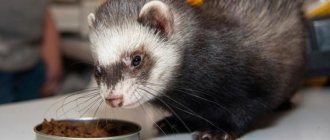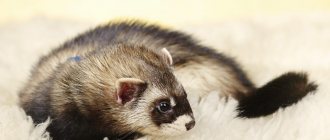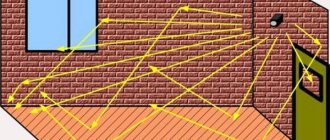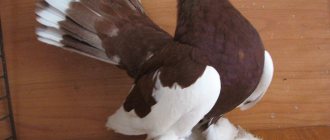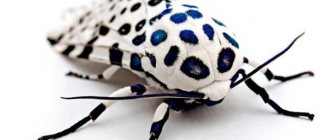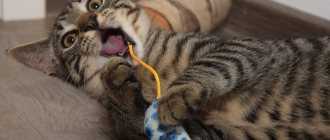Livestock » Ferrets
1
2034
Article rating
Kira Stoletova
The ferret is a very interesting and funny animal that people have recently often kept as a pet. He can be called sociable, as he loves to talk. The main thing is to understand what certain ferret sounds mean. By nature, ferrets tend to lead an active lifestyle, but if they adapt to the home, the owner is perceived as part of the pack. If a person wants to know better what a pet feels, he needs to carefully study the description of the most common sounds that this small animal makes.
What sounds does a ferret make?
Newly born mammals make the simplest sounds; they are called “baby sounds”. You should definitely listen to the first sounds of a ferret: this way the owner will sooner learn to understand his pet.
What sounds ferrets make are also determined by the age, time of day and character of the animal.
The pet is more active at night; during the daytime it sleeps. During the day, an animal can sleep 15-20 hours, so many owners do not even hear their pet talk, and the presence of their own language in animals greatly surprises them.
Sounds a ferret can make
Every year the popularity of keeping unusual and wild animals at home is becoming more and more popular.
More and more people are choosing exotic pets such as ferrets. The owners of these animals note that they are emotional, talkative and active. Unfortunately, they do not know how to pronounce words, but they can make all sorts of sounds characteristic of a particular situation. The sounds made by ferrets serve not only for the animals to communicate with each other, but also as a way to inform the owner about the pet’s dissatisfaction.
If you want to have a lot of fun and good mood with ferrets, you will have to learn to understand and recognize the sounds of ferrets. Whatever sound he makes, it definitely expresses his emotion or state. And their emotions may be as follows:
- joy;
- satisfaction;
- pain;
- great mood;
- fear;
- anger.
- 1 Cluck
- 2 Hissing
- 3 Sharp piercing scream
- 4 Squeak
- 5 Summary
Pet sounds
The sounds of poultry and farm animals are known to everyone from early childhood
. We were all taught how a cow, a cat and a dog speak. However, even in the usual examples there are exceptions, such as with the Basenji.
What sounds do birds make?
The sounds made by birds that live at home vary greatly. Children are taught how a chicken speaks, and some of them mistakenly believe that this is how most poultry speak. For example, a turkey, which is very similar to a chicken, does not crow, but cackles loudly
Cooing domestic pigeons or chirping parrots are even more different: it is important to explain to your child the difference between these birds
, and not just talk about the sounds they make.
When teaching children to pronounce animal sounds, do not forget about two simple rules:
Do not focus your child’s attention only on the voices of animals, especially if he is not interested in this yet. In order for the sounds made by animals to be imprinted in memory, they need to be spoken regularly.
As an example of an unusual way of communication, it is worth mentioning African domestic dogs.
The Basenji is a hunting dog breed native to Central Africa. It was first brought to the Congo as a gift to the Egyptian pharaohs. In America and Great Britain it became popular only in the 19th century.
These dogs can't bark
due to its specific narrow larynx. Instead, Basenjis make dull sounds, somewhat similar to the growl of a regular dog.
Perhaps the breed’s inability to bark is associated with breeding work: since they were bred for hunting, barking could interfere and attract unnecessary attention
Dogs are famous for their playfulness and stubbornness. They are very smart and quick-witted, but do not always strive to take the initiative in learning commands - sometimes the Basenji simply ignores its owner. But in general, these dogs are excellent companions, you just need to get used to their sound.
Hissing
This sound is a little less common. It can also be listened to while your ferret is playing. Only in this case, he does not feel joy from what is happening, but, on the contrary, gets angry, tries to take away his favorite toy, or he doesn’t like something. Very often, ferrets, after playing with their toy, try to drag it into their house, into their hole. At the same time, the size of the passage with the toy is incommensurate. But they will still puff up, get angry and try to do it, accompanying their actions with hissing.
The ferret also hisses at the sight of his relative and before a possible fight, showing his anger, aggression and fighting mood. It hisses once, but can do this many times, almost continuously for up to 3 minutes.
Preparation and care
Before you get a ferret, you need to prepare:
- Do a thorough cleaning of the room, the pet does not like dirt.
- Close cracks and passages where it might get stuck.
- Hide sharp objects, chemicals, cosmetics.
- Set up a separate corner, lay a bedding, buy a drinking bowl, a bowl.
- Apply film to windows or purchase blinds to protect your pet from heat stroke. Comfortable temperature for a ferret is from 10 to 25°C.
Often the ferret is kept in a special metal cage. It needs to be equipped: put a drinking bowl, feeder, tray and create labyrinth passages that the pet loves so much, build swings, ladders and boxes.
Like any animal, a ferret needs to be bathed periodically. Water procedures are carried out no more often than once every 30 days, and the water temperature should not exceed 40°C. Afterwards, the animal is wrapped in a towel and allowed to dry on its own.
Once every 1-2 months you should trim your nails, but this must be done with extreme caution so as not to touch the vessel in the nail plate. A ferret at home does not require combing, only in rare cases during molting in spring and autumn
To feed adult ferrets, 3-5 meals are sufficient. The diet should include:
- rodents;
- poultry (especially bones and cartilage);
- quails, quail eggs;
- beef, lamb;
- maggots and Madagascar cockroaches.
But since it is not always easy to find such specific products even in Penza, it is easier to switch the ferret to ready-made food, but taking into account the peculiarities of its metabolism. The composition of the granule should be 20% fat, 32% protein, 3% fiber. It is forbidden to feed them fatty, smoked, fried, sweet and flour products - the animal is not able to digest them. It is not recommended to give nuts, vegetables and fruits.
Budgerigars - care and maintenance, hygiene
02 Nov 2018
Read the article
The budgerigar is an agile, bright, small bird native to Australia. By nature, the exotic has plumage of yellow-green or blue shades with characteristic wavy patterns. As a result of selection, many birds of a different color appeared - white, gray-green, purple, olive, yellow. Ideal for home maintenance, easily adapts to the microclimate of the apartment and its inhabitants. They are able to imitate human speech (words and short phrases) without understanding the meaning.
A sharp piercing scream
The ferret screams very loudly and shrilly if he experiences pain, for example, he has stepped on his tail or paw, he has been injured, or something has frightened him greatly. Similar sounds will also be made during fighting or mating.
The ferret produces a sharp, piercing cry during mating and when it feels severe pain.
Having heard such a cry, you need to urgently check how your pet is doing: perhaps he is in trouble and needs help.
The ferret squeaks quite rarely. Usually the animal makes a faint squeak when it sleeps. At the same time, he can twitch his paws, tail or head. A stronger squeak may also indicate that the ferret felt pain.
If he was picked up and he immediately let out a squeak, it means that something is wrong with him - it is possible that he may have an injury in the place where the hand is wrapped around him. In this case, he should be shown to a veterinarian.
A domestic ferret can make a quiet squeak even while sleeping.
Summary
Have you already purchased or are planning to purchase a ferret? Try to understand the peculiarities of his behavior, study what sound the ferret makes. He can not only make sounds, but also “speak” with parts of his body. For example, if he fluffs his tail and hisses at the same time, it means that he is very irritated by something and is aggressive. In this case, you need to pick him up and stroke him so that he calms down. There are many similar examples. Watch your pet carefully, and the sound it makes will help you strengthen your trusting relationship with it.
Unusual screams and songs
Funny animal sounds seem funny only to us. For example, the singing of the Egyptian dove at first represents the usual cooing of a pigeon, but after a few chords this bird necessarily adds a semblance of caustic and even mocking human laughter. In a zoo or farmstead it sounds funny, but somewhere in an oasis in the middle of the desert, a random traveler may well imagine something mystical.
Different natural conditions have their own unusual sounds that amuse or terrify. For example, the woodpeckers of our forests cannot sing at all, so they have mastered percussion instruments. The feathered bird manages wood chips so well that this drum trill can be heard several kilometers away. He informs the female about the groom's expectations, while filling the forest with a charming sonorous beat.
What sounds does a ferret make and why?
The ferret is a very interesting and funny animal that people have recently often kept as a pet. He can be called sociable, as he loves to talk. The main thing is to understand what certain ferret sounds mean. By nature, ferrets tend to lead an active lifestyle, but if they adapt to the home, the owner is perceived as part of the pack. If a person wants to know better what a pet feels, he needs to carefully study the description of the most common sounds that this small animal makes.
What sounds does a ferret make?
Newly born mammals make the simplest sounds; they are called “baby sounds”. You should definitely listen to the first sounds of a ferret: this way the owner will sooner learn to understand his pet.
What sounds ferrets make are also determined by the age, time of day and character of the animal.
The pet is more active at night; during the daytime it sleeps. During the day, an animal can sleep 15-20 hours, so many owners do not even hear their pet talk, and the presence of their own language in animals greatly surprises them.
Interesting facts about ferrets
Ferrets love to nip and bite their owners' fingers to get attention.
The animal can sleep up to 20 hours a day. The animals have poor vision and do not distinguish colors, but they have excellent hearing and sense of smell. The animal cannot be brought into Australia. Hunting with a ferret for rabbits or hares, ferretting, used to be very popular in Britain. Ferrets are better than cats when it comes to protecting your home from rats and mice because they can crawl into a hole and get the rodent out. Pet ferrets are illegal in California and New York. Da Vinci's painting "Lady with an Ermine" depicts a white furo ferret, not an ermine. The animal in the painting is the size of a cat; the real ermine is much smaller. Ferrets rarely attack adults, but view unattended infants as prey. In the United States, there were cases in 1991, 2000 and 2011 in which, due to parental negligence, infants were seriously injured or died from ferret bites. There is an unusual “ferrets in pants” competition. Participants put 2 live ferrets in their pants, the pants are tightened at the waist and ankles. According to the rules, wearing underwear is prohibited. The animals bite and scratch, trying to get out, so few survive more than a minute. In 2010, two men set a record by holding out for a record 5.5 hours.
Ferret 5 (100%) votes: 2
Main types of sounds
Among all the sounds that these animals produce, the following should be highlighted:
If the sounds made by ferrets resemble a squeak, this means that the animal is defending itself. Most often, a person hears a squeak during sleep, when the pet has a dream in which it is fighting or running away from a predator. If he dreams of a chase or run, at this moment he will not only make a sound, but in addition he will jerk his tail or limbs.
If he starts squeaking when he is picked up, you need to seek help from a specialist, because ferrets make similar sounds when something is wrong with their health, that is, there is a certain discomfort. During the examination, the doctor will visually examine the animal and, if necessary, take tests. In order to prevent such situations, it is necessary to undergo examination every 6 months, even if the animal feels well.
Review from one of the readers
Despite the fact that we are talking about the sounds made by a ferret, I could not ignore the tail. When an animal is frightened or smells unfamiliar and suspicious odors, it fluffs up its tail, which becomes like a toilet brush.
Sometimes a ferret can twitch its tail, which I didn't know before. But one day, after hiding his favorite squeaking toy under the blanket and squeaking it several times, I noticed how my ferret began to vigorously twitch his tail, as if sweeping a sheet. I even recorded it on video, now you can watch it too. Most likely, this was how he expressed his concern for the toy, he was nervous.
Ferret cry
What sounds does a ferret make if its tail is accidentally caught in a door? It's normal for him to start screaming. In these animals, like in people, screaming is a defensive reaction, and if the pet feels some kind of discomfort or is dissatisfied with something, it begins to scream at the top of its lungs. By shouting, he hopes to reach the owner and ask: why don’t you notice me? Experts have proven that ferrets make such sounds when they have a sudden change in mood, sometimes even unexpected for the animal itself. The cry can begin when the owner holds several males, who begin to fight for the female. The animals also produce this sound during copulation.
Where to buy ferrets.
This animal can be purchased from breeders, markets, pet stores and fur farms that breed ferrets for fur.
Approach the purchase of a ferret soberly and do not choose the price as the main criterion, because you are purchasing an animal for many years. The cheapest ferrets are always the most problematic: aggressive, cowardly, often sick.
Breeders
Like any pet, it is best to purchase ferrets from breeders, that is, people who deal with them professionally. But not every person who has ferrets born at home can be considered a breeder. There are also people who are poorly informed about ferrets and people who breed ferrets only for profit. Buy ferrets from a competent breeder for whom animals are not just a business.
Pet shops and markets
We categorically do not recommend buying ferrets at markets and pet stores. Ferrets sold in pet stores usually come from inexperienced ferrets, which does not allow a real breeder to sell puppies to markets and stores.
An undoubted disadvantage of purchasing an animal from a pet store is the lack of “after-sales support”, which can only be provided by the breeder. And if for some reason the ferret is not suitable for you, you will not be able to return it back, since, according to current legislation, animals cannot be returned.
Another disadvantage is that the puppy’s parents are unknown; it is impossible to assess how healthy the mother is and in what conditions she was kept. Obviously, the health of the litter greatly depends on the conditions during pregnancy.
All of the above is true for markets, but in addition, buying in the market involves another risk. Most sellers on the market are resellers, no matter what they say about themselves. Their ferrets mainly come from fur farms, that is, they were raised surrounded by semi-wild and aggressive relatives. It is not easy to wean such ferrets from biting. Knowing this, sellers claim that their animals are home-bred.
But the biggest disadvantage of purchasing such a ferret is its poor health. It is rare that a fur farm ferret lives to be 5-6 years old, although the potential lifespan of these animals is much longer. Basically, by the age of 3-4 years, chronic liver diseases begin (this is due to hormonal drugs used on fur farms and inadequate feeding of females during pregnancy), often kidney and spleen diseases. Such diseases cannot be treated; expensive procedures can only extend a pet’s life by 1-3 years.
Fur farms
Selection of ferrets in fur farms is carried out only for the quality of their fur, but never for peacefulness and neatness. “Farm ferrets” from an early age are often semi-wild and very aggressive; it is very, very difficult to re-educate them. Some ferret ferrets may remain feral throughout their lives.
Hissing in ferrets
If you listen to your ferret's sounds often, you can understand what emotion he is experiencing at the moment. The hiss is tantamount to a warning. This sound can be heard from the animal during play. If someone takes away his trophy or favorite toy, he begins to hiss. This is a way to show the degree of dissatisfaction with what is happening. It is also quite possible that a pet wants to drag a toy or trinket he likes into some secluded place, but he fails, as a result of which he begins to hiss, and you cannot explain to him that the object simply does not fit through the hole.
Convincing ferrets of something is very difficult, as they begin to try to fulfill their plans. Hissing is one of the sounds that ferrets often make; at this moment they look like a snake. If a fight is planned among ferrets, then this sound will be a signal to the enemy, thus small predators show their power and importance.
domestic ferret
The ferret is a popular pet and was already domesticated by the ancient Greeks - the animal was mentioned by Aristophanes, Aristotle, Pliny the Elder and Strabo. The animal was often kept as a pet to protect it from mice and other rodents, and was used to hunt burrowing animals, mainly hares and rabbits. Since the 13th century, predators have been kept to fight rats on military and civilian ships. Since the 20th century they have been used in laboratory research.
The domestic ferret is a very active and energetic animal. The animal is very playful and intelligent, but willful, so it will need a lot of attention from its owner. Among the minuses, it is worth noting that animals often have an unpleasant odor, can dig and chew everything, on occasion they hunt other pets and can take revenge on the owner if they are offended. Domestic ferrets must be sterilized if you are not breeding them, and it is advisable to keep them in a cage so that the animal does not chew anything without supervision.
Sounds a ferret can make
Nowadays it is not uncommon to find an exotic animal kept at home. The ferret is the most domesticated species of wild animal. Ferret owners note that these animals are quite talkative. A ferret can make a wide variety of sounds, the correct understanding of which will help you understand your pet.
Ferrets are talkative creatures
The meaning of the sounds that ferrets make
Each time a ferret makes a certain sound, it expresses certain emotions:
- Joy or contentment.
- When in a good mood, ferrets “sing.”
- Aggression.
- Fear.
- Painful sensations.
Cackle
This type of sound can be heard from the animal most often. The sound produced can be compared to the clucking of a chicken. With this sound, an animal can express a wide range of emotions. Most often, the ferret experiences positive emotions when hearing such a sound.
Clucking can be heard from a ferret:
- When meeting another animal. When ferrets meet their own kind or animals of a different race, the ferret does not remain silent.
- Joy. If your pet is happy and happily playing with his toys, then clucking is often a sign of this emotion.
- Contentment.
- Sometimes, when your pet is worried or unhappy about something, your ferret may cackle.
The ferret gets excited and starts cackling.
Hiss
Ferrets make a variety of sounds. Hissing, which resembles a cat's, may accompany your pet's play. A ferret may hiss when you take away its favorite toy, or the animal tries to drag an object into its house. If the object exceeds the size of the hole in the hole, but the pet stubbornly tries to hide the thing in it, then the hissing accompanies anger.
When attacking, an animal can make such a sound to show its opponent its aggressive attitude or superiority.
A sharp and loud scream
Whatever sounds the ferret makes, each of them expresses its emotion. Cutting and high-pitched squeaking means your pet is in pain. In such a situation, you should pay close attention to this and immediately rush to his aid. Maybe he is in a bad situation and you need to step in to help him.
If you step on a paw or tail, you will hear a high-pitched scream. This also indicates pain caused. You should be more careful when handling the animal.
This sound also occurs during mating.
Ferrets make loud noises when mating
This sound can be heard most often when the ferret is resting or sleeping. If he dreams about something, he squeaks, twitching his paws and head. Yes, these animals dream, and what kind they dream, we can only guess.
If you pick him up and the place where you touched him hurts, the ferret may squeak. Examine it carefully and if you find an injury, contact your veterinarian.
If you have just acquired an exotic pet, then you should know about one more feature in the behavior of this animal.
If you notice that in addition to sounds indicating aggression, the animal has fluffed its tail, then you need to be careful and identify the cause of its anxiety. Having eliminated the pet's aggression factor, calm it down. Pick him up and stroke him.
If you carefully observe your pet's behavior, these animal sound cues will help you build a trusting relationship.
What is the voice of a ferret?
Hori are generally silent throughout their lives. And they start talking only when they experience strong emotions . But sometimes there are also very talkative individuals. The sounds ferrets make depend on what they are experiencing.
Representatives of the mustelid family have their own voice for each emotion. Thus, they express their dissatisfaction with a characteristic hiss , joy with a peculiar purr , and so on.
What do ferret sounds mean?
What sounds ferrets make depends on their age, health status, and time of day. Representatives of the mustelid family are characterized by nocturnal activity, but during the day they mainly rest. In general, they spend a lot of time sleeping , about 20 hours a day . This is why some owners are surprised when they hear their pet’s voice for the first time.
What the tailed one is trying to say depends on whether it squeaks, screams or coos. This is often how ferrets show it:
- Fun, playful mood
- Satisfaction, contentment
- Painful sensations
- Joy
- Fear
- Aggression, anger, despair
Clucking or grumbling
The ferret makes this sound very often. Due to the fact that it is similar to the cackling of a bird, it is called that. You can hear it during the period of your pet’s initial acquaintance with other representatives of the animal world or during pampering and games.
Grunting reflects the emotional background of the animal, because it is heard during mating games (one of the methods of attracting a female), calling its flock, etc.
WHAT SOUNDS DO FERRETS MAKE? HOW FERTLES COOK. PET FERTLE | MY FERTLE
Types of sounds
Each emotion has a corresponding soundtrack. Among them:
- Squeaking . Display dreams, health problems
- Screams . Indicate physical pain, fear
- Hissing . A warning shot of sorts
- A rumbling sound that resembles a cackle . Displays a wide range of emotions, mostly positive
- Creak . Characteristic of newborns
Squeaks
Usually published in a dream, but quite rarely. They are often accompanied by twitching of the legs, head, and tail . If squeaks occur outside of sleep, this is an alarming signal.
When a pet squeaks in your arms or while walking, it most likely experiences pain. It is necessary to carefully examine the ferret to see if its paws or body are damaged.
If the squeaks are repeated constantly and the animal is not sleeping, then you need to take it to the veterinarian. Since constant squeals may indicate the presence of a disease.
The veterinarian will examine him thoroughly and, if necessary, send him for tests.
Sharp cry
The sharp cry of a ferret resembles the cry of seagulls. It directly indicates that the animal is in pain. You can hear a ferret scream when a person accidentally steps on the pet’s paw or tail , and also when the animal is experiencing discomfort or is simply unhappy.
A pet may scream if it is very frightened, falls, or other physical sensations. That is why it is important to come running when the rodent calls and make sure that everything is fine with him.
Squealing can mean a sudden change in mood, so this phenomenon is often observed during the rut.
Furos often scream when they fight among themselves.
Hiss
The hiss of ferrets is similar to that of a cat or a snake. A kind of warning, an expression of dissatisfaction, annoyance, anger. You can often hear hissing when playing with an animal.
The rodent hisses at something specific. To another pet, so that he does not come close, the owner, if he takes something away from the ferret, the ferret will hiss when he fails to drag his favorite toy into his hiding place, and the like.
In the wild, horis hiss at each other before starting a fight. With the help of this sound, predators show their strength and importance.
When it hisses, the furo opens its mouth wide, resembling a snake. The animal hisses once or continuously for 3-5 seconds. If a four-legged animal hisses continuously, it means that it is very excited or irritated by something. Here you need to calm the furo by eliminating the irritant. If you cannot find the source of aggression, you need to take the pet, pet it, calm it down, and take it to another room.
Clucking or purring
The most common voice of a ferret is reminiscent of the clucking of a chicken and the cooing of pigeons. Rodents cackle almost every day. Ferrets purr in moments of positive emotional arousal: when meeting new pets, while having fun, walking, exploring the territory.
Hori communicate with each other in this way, calling each other. During the rutting season, the hori attracts the female with its continuous purring.
A nursing female talks to her babies while cooing.
Basically, rumbling reflects the pet's contentment, joy, good mood, self-confidence, and friendliness. Less often, rumbling can indicate dissatisfaction or excitement of the animal.
Creak
Rodents “creak” only in the first months of life. The squeak is quite loud and frequent. In this way, little ferrets try to tell their mother that they are cold and hungry. The creaking completely disappears around the second month of life.
Lifestyle
The ferret is a nocturnal predator. During daylight hours it rests in the hole, and at night it is active. Moreover, a nocturnal lifestyle is characteristic of both wild ferrets and domestic ones. However, domestic ferrets adapt over time to their owner's rhythm.
- What does a ferret eat? The basis of the diet is animal meat. He hunts mice, rabbits, hares. It silently sneaks up on prey and will attack even large birds. It often destroys other people's nests, eating not only eggs, but also chicks. It also feeds on insects, beetles, larvae and reptiles such as frogs, snakes, and newts. Ferrets are quite fearless. They even attack poisonous snakes and hedgehogs. Hedgehog spines are not scary for a ferret. Having an elongated flexible body, he dodges the hedgehog's attacks with dexterity. At home, ferrets are also fed meat food: chicken, rabbit, beef, veal, turkey. The ferret is very thrifty. With the onset of cold weather, he makes provisions for the winter. The ferret hides everything that he does not eat in a secluded place.
- Ferret's enemies. Despite the fact that the ferret is a predator, he himself is often attacked by other predatory animals. The danger for him is wolves, foxes, dogs, lynxes, eagle owls, owls, hawks, and golden eagles. But the ferret knows how to stand up for himself. It has paraanal glands under its tail. At the moment of danger, when the ferret is frightened, the glands secrete a secretion with an unpleasant odor. This confuses the enemy and gives the ferret the opportunity to escape.
- How long does he live? In the wild, ferrets live only 3 to 5 years. Such a low life expectancy is associated with constant stress, lack of food, disease and attacks by predators. At home, ferrets live much longer, from 8 to 10 years. Individuals who have lived 12-15 years are considered long-livers.
- Reproduction of ferrets. In nature, ferrets often mate; females become pregnant 2-3 times a year. This lifestyle significantly reduces life expectancy, since the process of bearing, giving birth and caring for cubs takes a lot of strength and energy from the female. After mating, the male immediately leaves the female and does not take part in raising the offspring. At one time, the female brings from 6 to 18 cubs, depending on the species. Puppies are born blind and helpless. For the first 3-4 weeks, the mother feeds them milk, then begins to feed them regular food. Babies go hunting at the age of 3 months under the supervision of their mother. By the age of 6 months, they leave their mother and begin an independent life.
The ferret spends all his time searching for food and hunting. It has strong, muscular paws and long claws, making it good at climbing trees and digging holes. Many individuals can swim. But they do not hunt for fish. The thing is that the ferret's digestive system is capable of digesting only meat food. It is unable to digest coarse plant fibers and fish.
Wild individuals are quite aggressive, it is almost impossible to tame them. Only one type of ferret is suitable for home keeping, which is called the ferret. They have a calm and peaceful character.
Domestic animals are often called honoriki, but this is incorrect. Honorik is an artificially bred species obtained by crossing a European mink and a ferret. This species received the name honorik by adding the initial syllables from its parents: “ho” - ferret, “nor” - mink. The Honorik population is becoming smaller every year due to difficulties with breeding, since the European mink is on the verge of extinction.
Wild ferrets are very interesting animals. The appearance of ferrets also does not go unnoticed. Their lifestyle, habits and character can be studied for a long time. They rarely sit in one place and are constantly on the move.
What sounds does a ferret make?
Nowadays it is not uncommon to find an exotic animal kept at home. The ferret is the most domesticated species of wild animal. Ferret owners note that these animals are quite talkative. A ferret can make a wide variety of sounds, the correct understanding of which will help you understand your pet.
Ferrets are talkative creatures
The meaning of the sounds that ferrets make
Each time a ferret makes a certain sound, it expresses certain emotions:
- Joy or contentment.
- When in a good mood, ferrets “sing.”
- Aggression.
- Fear.
- Painful sensations.
Cackle
This type of sound can be heard from the animal most often. The sound produced can be compared to the clucking of a chicken. With this sound, an animal can express a wide range of emotions. Most often, the ferret experiences positive emotions when hearing such a sound.
Clucking can be heard from a ferret:
- When meeting another animal. When ferrets meet their own kind or animals of a different race, the ferret does not remain silent.
- Joy. If your pet is happy and happily playing with his toys, then clucking is often a sign of this emotion.
- Contentment.
- Sometimes, when your pet is worried or unhappy about something, your ferret may cackle.
The ferret gets excited and starts cackling.Hiss
Ferrets make a variety of sounds. Hissing, which resembles a cat's, may accompany your pet's play. A ferret may hiss when you take away its favorite toy, or the animal tries to drag an object into its house. If the object exceeds the size of the hole in the hole, but the pet stubbornly tries to hide the thing in it, then the hissing accompanies anger.
